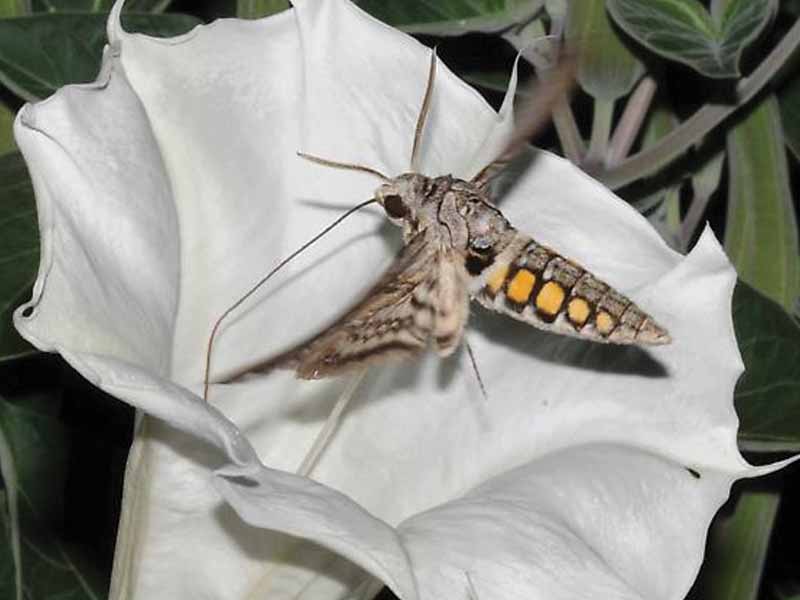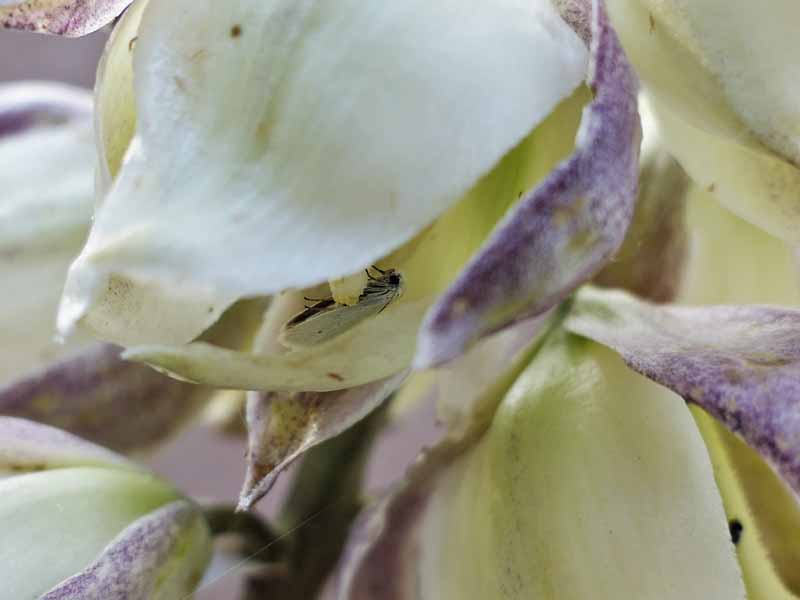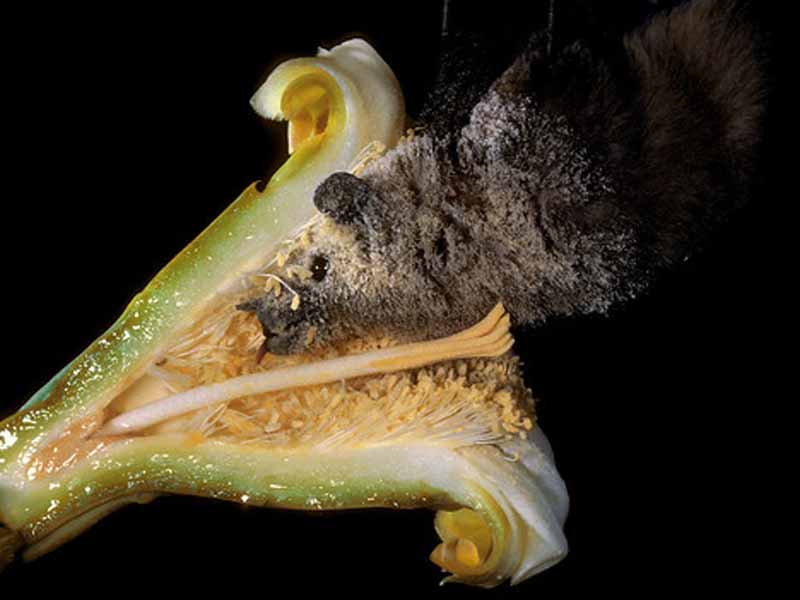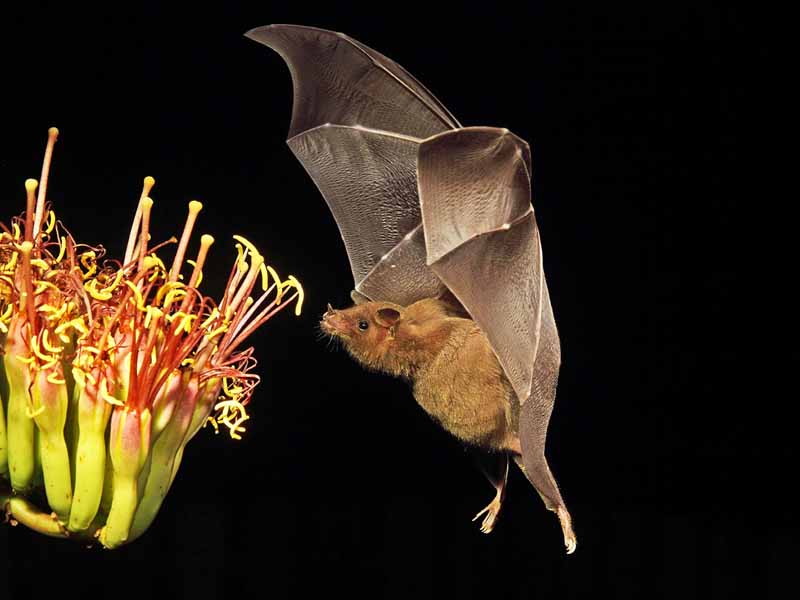Header Photo: John Hoffman

Many people are familiar with honeybees, birds and other species that are daytime pollinators, but which ones are busy working at night? Nocturnal pollinators are understudied, especially when compared to diurnal ones. These night workers and the plants they pollinate are often coadapted to one another, with unique relationships and features. The plants often have flowers that open at night or in the evening, with strong fragrance and lots of nectar, and are mostly white or light colored. The scent and nectar lure pollinators in and light colors make flowers easier to find in moonlight. Datura, evening primrose, sweet four o’clocks, saguaro, organ pipe cactus, cardón, night-blooming cereus yuccas and agaves are a few examples of plants that you can find nocturnal visitors hanging around.
In addition to being understudied themselves, we don’t really know the scale at which these species contribute to pollination as an ecosystem service, for crops or wild plants. A few examples of nocturnal pollinator relationships in the Sonoran Desert include bats and visiting saguaros and agaves and yucca moths visiting yuccas and hawk moths (Sphingidae Family) visiting datura. Moths and bats often get a bad rap, with moths seen as destroyers of clothing and crops, and bats as scary disease carrying rodents. While bats can carry pathogens that cause disease, the risk of infection from a bat is extremely low, and bats don’t go out of their way to attack humans. Even bites from vampire bats (subfamily Desmodontinae) are rare. Bats specifically are responsible for pollinating many of the food crops we eat, including figs, dates, mangoes, peaches and bananas. Some studies have estimated that by eating insects, bats provide a pest control service for US agriculture estimated to be worth more than $3.7 billion per year, and possibly as much as $53 billion play a major role in tequila production, being primary pollinators of agave. While some moth larvae do eat clothing, moths actually make a considerable contribution as pollinators, including food crops. Pollination by moths is more common here in the Sonoran Desert, thanks to favorable environmental conditions. A recent study from shows that moths are likely greater contributors to pollination than previously thought and for a greater diversity of plants, including those less visited by bees.
Moths and bats are some of the more well-studied nocturnal pollinators, but many different species are active at night, including beetles and flies. Did you know there are even nocturnal bees? As we learn more about nocturnal pollinators, we’re increasingly finding that they play a larger role in pollination services than previously thought. We’re more familiar with the decline in daytime pollinators, especially native bees, but what could be happening to nocturnal pollinators we hardly know much about? Over half of bat species are already listed as threatened or endangered, and we are learning that plants lit with artificial light at night have less nighttime visitors. Could we be losing nocturnal pollinators before we even have a chance to understand them? When we think about pollinators, it’s important to remember the ones working the night shift are worthy of conservation consideration too.
Observations from this EcoQuest can contribute data and information for nocturnal pollinator relationships and ecosystem services in metro Phoenix. We can learn more about which species are visiting which plants and how they contribute to pollination. Observing nocturnal pollinators at work can also increase appreciation and understanding of them.
WHAT TO OBSERVE
If you catch a pollinator in action, be sure to upload an observation for the pollinator AND the plant. You can use the same image, but make two observations:
Plants (Kingdom Plantae)
Bats (Order Chiroptera)
Butterflies and Moths (Order Lepidoptera)
Beetles (Order Coleoptera)
Flies (Order Diptera)
Thrips (Order Thysanoptera)
Ants, Bees, Wasps, and Sawflies (Order Hymenoptera)
EcoQuests are month-long challenges that are part of the larger Metro Phoenix EcoFlora project.
You can learn more and join the Metro Phoenix EcoFlora here.
Sign up for the newsletter at [email protected].
Let’s be social @ecofloraphx
Please do not observe indoor houseplants or pets.
For your own safety and the protection of plants and wildlife, do not trespass when making observations. Please follow all posted rules and guidelines in parks/preserves and do not enter private property.
Do not remove or move natural materials (plants, animals, rocks).
Respect wildlife (do not touch, feed, or disturb animals and keep a safe distance).

Photo: Sara Wright

Photo: Kaitlin Haase

Photo: Marlin D. Tuttle
